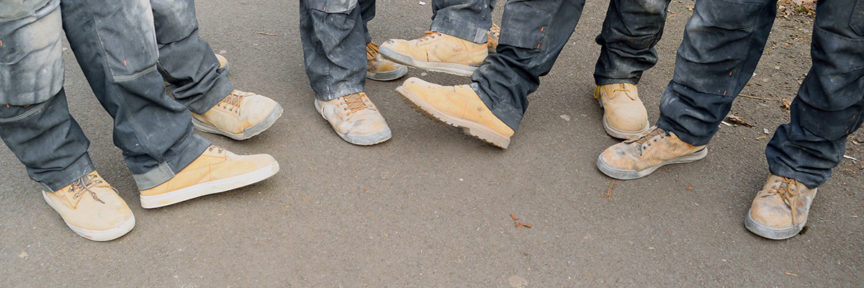Wearing the Right Shoes for the Right Job!
Having the right footwear for the job is critical to your safety and prevention of injuries. Think of yourself as an athlete who needs specialty footwear for your sport. Your tennis shoes may be comfortable, make you run faster, and jump higher—but they may not be appropriate for your work environment. Would you play basketball with golf shoes on, use swim fins to run the hundred-yard dash, or wear sandals to go skiing? Of course not. That’s ridiculous. The operations you complete every day will dictate what the appropriate protection against foot injuries should be. Here are some things to consider.
According to the National Safety Council, as many as 130,000 disabling foot injuries and 40,000 toe injuries occur on an annual basis. General hazards to your feet on the job are: heavy objects fall on them, heavy objects roll on them, or toes are stubbed on immovable objects. The wrong footwear can also cause you to slip and fall, resulting in multiple injuries. The shoe material must also be appropriate for your work environment. Your work shoes should fit properly, be comfortable to wear, and shouldn’t be defective in any way or worn out.
Even office workers need to be aware that certain footwear is not appropriate for their work environment. A recent injury involving an outwardly opening door and a worker wearing sandals, resulted in a surgical procedure for the removal of a toe nail.
If you work in areas where your footwear could be punctured by nails or other sharp objects, you should wear shoes with metal insoles or reinforced soles. If you work with electricity, you need non-conducting shoes with neither steel toes nor soles with metal components. If you deal with corrosive chemicals or neoprene, chemically impenetrable rubber boots should be worn. If your walking surfaces are wet or oily, your footwear should have slip-resistant or oil-resistant soles.
If safety toes are essential at your workplace because of a high probability that a heavy object could fall on your foot, there are many varieties of footwear with protective toes to choose from. If you are concerned that steel-reinforced toes will cause your feet to be cold, several manufacturers make safety shoes with fiberglass-reinforced toes. Just be sure that your safety footwear meets the ANSI Z41 1991 requirements established by OSHA’s 29 CFR 1910 final rule of October 1994. Most quality occupational-safety footwear manufacturers comply with these standards—but since it’s your safety at stake, it is also your obligation to ensure that the shoes you’ve selected to wear are appropriate for your exposure.
Remember—as an occupational athlete, you need the right footwear to perform optimally and safely. Take a good look at your work shoes. Are they right for your job?

